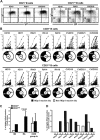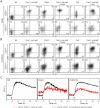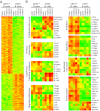Complement receptor 2/CD21- human naive B cells contain mostly autoreactive unresponsive clones
- PMID: 20231422
- PMCID: PMC3373152
- DOI: 10.1182/blood-2009-09-243071
Complement receptor 2/CD21- human naive B cells contain mostly autoreactive unresponsive clones
Abstract
Complement receptor 2-negative (CR2/CD21(-)) B cells have been found enriched in patients with autoimmune diseases and in common variable immunodeficiency (CVID) patients who are prone to autoimmunity. However, the physiology of CD21(-/lo) B cells remains poorly characterized. We found that some rheumatoid arthritis (RA) patients also display an increased frequency of CD21(-/lo) B cells in their blood. A majority of CD21(-/lo) B cells from RA and CVID patients expressed germline autoreactive antibodies, which recognized nuclear and cytoplasmic structures. In addition, these B cells were unable to induce calcium flux, become activated, or proliferate in response to B-cell receptor and/or CD40 triggering, suggesting that these autoreactive B cells may be anergic. Moreover, gene array analyses of CD21(-/lo) B cells revealed molecules specifically expressed in these B cells and that are likely to induce their unresponsive stage. Thus, CD21(-/lo) B cells contain mostly autoreactive unresponsive clones, which express a specific set of molecules that may represent new biomarkers to identify anergic B cells in humans.
Figures







Comment in
-
The anergic B cell.Blood. 2010 Jun 17;115(24):4976-8. doi: 10.1182/blood-2010-03-276352. Blood. 2010. PMID: 20558622 No abstract available.
-
CD21low B cells in common variable immunodeficiency do not show defects in receptor editing, but resemble tissue-like memory B cells.Blood. 2010 Nov 4;116(18):3682-3. doi: 10.1182/blood-2010-05-285585. Blood. 2010. PMID: 21051568 No abstract available.
References
-
- Nemazee D. Does immunological tolerance explain the waste in the B-lymphocyte immune system? experiment and theory. Ann N Y Acad Sci. 1995;764:397–401. - PubMed
-
- Radic MZ, Weigert M. Origins of anti-DNA antibodies and their implications for B-cell tolerance. Ann N Y Acad Sci. 1995;764:384–396. - PubMed
-
- Goodnow CC, Sprent J, Fazekas de St Groth B, Vinuesa CG. Cellular and genetic mechanisms of self tolerance and autoimmunity. Nature. 2005;435(7042):590–597. - PubMed
-
- Goodnow CC, Crosbie J, Adelstein S, et al. Altered immunoglobulin expression and functional silencing of self-reactive B lymphocytes in transgenic mice. Nature. 1988;334(6184):676–682. - PubMed
-
- Erikson J, Radic MZ, Camper SA, Hardy RR, Carmack C, Weigert M. Expression of anti-DNA immunoglobulin transgenes in non-autoimmune mice. Nature. 1991;349(6307):331–334. - PubMed
Publication types
MeSH terms
Substances
Grants and funding
LinkOut - more resources
Full Text Sources
Other Literature Sources
Medical
Molecular Biology Databases
Research Materials
Miscellaneous

